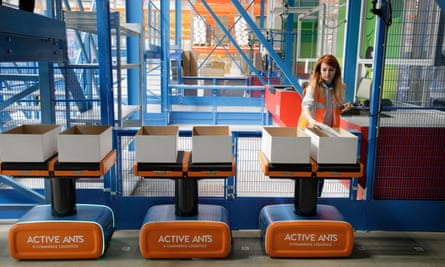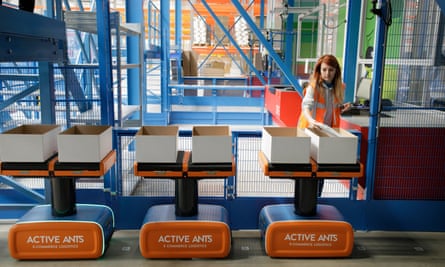With a low electrical hum, a small team of boxy, wheeled robots called “ants” criss-cross the top of a giant 3D grid of grey storage crates – 60,000 of them – ceaselessly arranging and rearranging them to order.
Down on the warehouse floor, flat-topped “ranger” robots ferry cardboard packing boxes around. Just one man, jokingly known as the robot whisperer, walks among them with a laptop.
It would be hard to conceive of a more vivid example of robots taking on human jobs.
“As robot technology advances, we can use them more and more, together with humans, to do useful work, and I think this is the future,” says Jeroen Dekker, co-founder of Active Ants, the Dutch firm behind this newly opened e-commerce warehouse outside Northampton. “Yes, some jobs are disappearing, but that’s the nasty jobs, for which we cannot find enough people.”
He may have a point – research commissioned by the TUC from the Centre for Research on Employment and Work (Crew) at the University of Greenwich after the Covid pandemic said automating warehouse roles “might be necessary to save the cost to human physical and mental health”.
But the rise of the robots, in this and many other workplaces, raises profound questions about the impact of automation on workers and the wider economy. It is a debate that has become all the more urgent in recent months, with the development of large language models (LLMs) such as ChatGPT, which can take on ever more sophisticated tasks.
There are still a few human workers at Active Ants – but they are not walking back and forth across the warehouse. Instead, they stand at a packing station and are presented with the correct grey bin by the robot-led storage system.
Today, they are dispatching clothes for retail clients. They lift out the goods and pack them into an appropriately sized box, brought by a ranger robot which waits until it is fully loaded before whizzing it away to be sealed and dispatched.
“We still need people: you can see technical people moving about, making sure the robots are OK; you can see the people picking from the bin to the box. We still need those people, but that obviously is much lighter work than walking a lot of miles through the warehouse to get the products from everywhere,” says Dekker. “The heavy work has been taken over by robots.”
In a warehouse of this size operating on the standard e-commerce model, there might be 1,000 workers. So far, Active Ants – which is three-quarters owned by bpost, the Belgian equivalent of Royal Mail – only has 11 retail clients here. But even when it is running at full capacity, it should only need about 250 staff – and 400 robots.
Abby Gilbert, director of praxis at the Institute for the Future of Work thinktank, says the capabilities of robots have been evolving fast – not least because of developments in AI that allow the software behind them to become ever more sophisticated.

“What we’ve seen, even in the last months or so, is a rapid advancement in robotic technology, which is obviously about the development of AI and its programming, its coding,” she says.
The software behind the robots at Active Ants iteratively calculates the most efficient placement of the 60,000 crates, given how frequently each product is ordered, and decides what size of box each individual order will need. When a robot’s battery is running low, it beetles off to a charging point.
Recent academic work has suggested the potential impact of AI may extend well beyond the low-paid staff, whose picking and packing roles are gradually being superseded.
A paper by a group of tech researchers published by Cornell University, suggested LLM-powered software may be what economists call a “general purpose technology” – something with as wide an application as, say, the steam engine or computers, which profoundly transforms the way the economy works.
The researchers predicted as much as 80% of the US workforce could see 10% or more of their tasks affected by LLMs. For 19% of workers, it could be half of their job or more – with higher-income roles affected most.
Gilbert says it is the widespread applicability of AI that makes it so hard to foresee what will happen next.
“We have tended throughout history not to be able to completely anticipate what the impacts of general purpose technologies will be in an aggregate fashion,” she says. “It could be impacting aspects of the way that all jobs are done, basically.”
Neil Carberry, the chief executive of the Recruitment Employment Confederation, says that, in the UK, rapid developments in AI, alongside difficulties hiring staff, are making firms across the economy reconsider how they use technology. “Everything is pushing companies right now to think about their mode of production. They’re thinking about what do the people do, and what do the machines do, in a way that maybe they haven’t for 20 years,” he says.
Part of the impetus for this rethink is the availability of automated solutions that would have been unthinkable even a year ago.
Ash Lewis is chief executive of the Yorkshire-based tech startup February, which has created an AI employee known as Avery, which (or who?) joins teams of software developers. “She currently has 180 jobs and she’s completing four new job interviews a day, and we have over 2,000 businesses that are waiting to interview her,” he says.
Avery autonomously checks the developers’ task list, selects the more straightforward ones and completes them autonomously before submitting the work for review by a human.
“She takes a task and then she breaks it down into subtasks; and then she creates clones of herself and one of those clones stays to manage the other clones,” Lewis says. “And then they regroup at the end, give feedback on each other’s work, then merge it all together and submit it to be reviewed by a human – and that process takes about 45 seconds.”
Constant feedback means Avery can learn rapidly. “We think that right now she’s basically on the level of a mid-level software engineer: someone who’s been doing it for maybe four, five years. We think by the end of this year she’ll be at a level with a senior, so that’s, say, seven to 10 years.”
He concedes the net result is likely to be that firms need fewer software developers, but points out there is a shortage of these highly skilled workers, who command eye-watering salaries – and adds that Avery’s human colleagues report finding their jobs more fulfilling, because some of the more tedious tasks are taken away.
Given the extraordinary pace of change, however, there are growing fears that one potential result of this latest wave of automation may be mass job losses.

Experts insist that is not a foregone conclusion – but much depends on how new technologies are adopted, and what policies are in place to support the transition to new jobs and approaches.
“We didn’t have a permanently unemployed population of grooms following the transition to the motor car. We had more mechanics,” says Kate Bell, assistant general secretary of the TUC. “There’s a lot of anxiety generated around this and less analysis of what is happening on the ground – how are we preparing for new jobs?”
Pointing to the harsh impact of recent uses of technology by firms in monitoring and managing low-paid staff such as delivery drivers, Gilbert says ensuring workers have a say in how it is adopted would make a big difference. “There’s lots of research that says that any kind of architecture for voice, be that a union or something else, enables you to better negotiate your own position through the transformation of automation.”
How policy and regulation adapts to the new technologies will also be crucial. The Labour leader, Keir Starmer, used a speech at London Tech Week to warn that if the arrival of AI was mishandled by politicians, the result could be akin to the rapid deindustrialisation of the 1980s, which left deep economic scars.
Some of the jobs likely to be replaced, including the gruelling warehouse shiftwork being picked up by robots at Active Ants, may not be much missed – but the question confronting policymakers will be what happens to the people and places hit hardest by automation. As Bell, of the TUC, puts it: “The question is, what is in place to ensure that you can get a rewarding job in your area? What is the industrial policy that means that there are jobs in new technologies?”
Join the exciting world of cryptocurrency trading with ByBit! As a new trader, you can benefit from a $10 bonus and up to $1,000 in rewards when you register using our referral link. With ByBit’s user-friendly platform and advanced trading tools, you can take advantage of cryptocurrency volatility and potentially make significant profits. Don’t miss this opportunity – sign up now and start trading!







Recent Comments